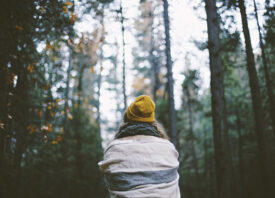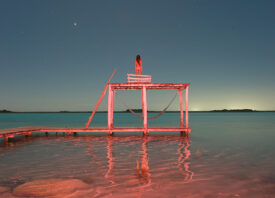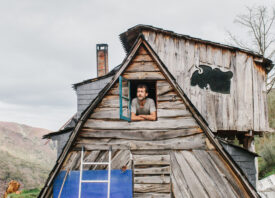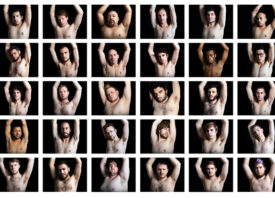Search this site
The Photographer Who Quit His Day Job to Travel Off-Grid

When the photographer Dan Grec was 27 years old, he decided to make a radical change. “I wanted to put myself out there and attempt something enormous,” he remembers now. After leaving his software engineering job, he hit the road. During that first off-grid photography trip, his Jeep Wrangler covered more than 54,000 kilometers, spanning the Pan-American Highway.
Now an experienced overlander and adventurer, Grec has traveled to some of the most inaccessible corners of the globe. The photographer has been an ambassador for Renogy, a brand offering leading solutions in sustainable solar energy, for eight years now. During that time, he’s driven a Renogy-equipped vehicle across the coastline of Africa (35 counties in all) and, more recently, embarked on a once-in-a-lifetime expedition through the Australian continent.
“With the near endless sun in Australia, the no-hassle system performed flawlessly in the most wild and remote destinations, including a ten-day crossing of the world’s most remote 4×4 track, over 1,000 miles without seeing another person or vehicle,” the adventurer remembers. These days, he’s working on a brand-new vehicle build using REGO, Renogy’s flagship off-grid solar power system. Once it’s ready, he’ll travel through the remote corners of Iceland and the Faroe Islands before exploring other parts of Europe.
We asked him to tell us more about his off-grid photography, the nights he’s spent in the wilderness, the routes that put his gear (and willpower) to the test, and the sunrises that took his breath away.

What inspired you to embark on your epic trip around Africa, starting in 2016? Did you know where the journey would take you when it started?
“After the Pan-American Highway adventure, I ran out of money, and I had to get another desk job to rebuild my savings account. I had been working at my new software job for less than a week when I realized that sitting at a desk for the rest of my life was not going to make me happy, and it was not something I could do forever.
“Early on, while working and saving money, I didn’t have a specific destination in mind. I just knew I needed to build a savings account so I could once again buy freedom from going to work every day. The parts of South America that stand out in my memories are when I was far from civilization and pushing my abilities to their limit, and so the more I thought about a future adventure, the more Africa fascinated me. I knew if I was going to ship my house-on-wheels vehicle all the way there, I should attempt to see as much of Africa as I possibly could.”

Can you walk us through a “day in your life” on the road? What does a typical day look like, if there is such a thing?
“I try as hard as I can to camp ‘wild’—just out in the wilderness away from people and infrastructure. Most mornings I wake with the sun, and I enjoy making coffee and breakfast in the early morning before the heat kicks in.
“Depending on where I am, I will drive for an hour or two and find myself in some kind of small town or village where I will wander a local street market, buy street food for lunch. If needed, I re-supply on food, gas and water. I love asking locals where I should explore or go next, and so with any luck, I will wind up at a waterfall, or lake, or mountain, or some other beautiful place I can hike and explore and hopefully camp for the night.”

In your years practicing off-grid photography, what was the most remote area you’ve ever visited so far?
“In Australia, together with my Dad, we drove the length of the Canning Stock Route, commonly called the world’s most remote 4×4 route. The track is 1,050 miles through the emptiness of the Western Australian deserts, and for ten days and nights, we did not see a single other person or vehicle. We were extremely far out, and very much on our own.
“The feeling of isolation was intense, and I was hyper aware that we would have to solve any problems on our own. Nobody was coming to save us. The Renogy system we had to power the fridge and run our water pump was absolutely flawless not only for this extremely remote section, but all around Australia in the intense heat and horrid corrugations.”

What are some misconceptions people have about your life on the road—or a life “off-grid” in general?
“I think many people assume living on the road means eating poorly, something like tinned food or ramen noodles for every meal. While this may have been the case twenty years ago, the advent of quality 12v fridges, solar and lithium batteries means this is no longer the case. My partner Katie and I cook and eat fresh meals with plenty of vegetables every day, and we always have plenty of fruit and healthy snacks in the fridge.
“I think people also assume life on the road must be very lonely and isolating, while the opposite is often true. Everywhere on the planet, there are people exploring, and they’re always looking to make connections with others on the road. Furthermore, locals are proud of their country and town, and they always jump at the chance to meet a foreigner and show them around their small part of the world. While on the road, I’ve had a more vibrant social life than when living in a city and going to work every day.”

What is the most powerful memory you have from all your years of traveling and shooting off-grid photography?
“On many occasions around Africa, I would arrive in a small mud hut village right around sunset. I was often exhausted, and felt very vulnerable. In all honesty, I even felt a little scared, and was worried how local people would react to a strange person showing up in their village in a big four wheel drive.
“On every single occasion, I was welcomed warmly by the village, and often locals tried to give me food and water, and were very happy to show me a place I could camp safely for the night. These people were not doing this because they wanted money, or anything like that, they were doing it because they’re friendly people, and welcoming strangers is part of the culture in Africa. I will remember the friendliness of the people all across Africa that I will remember as long as I live.”

What have been the most challenging aspects of life on the road? Have there been any moments where you considered giving up, and if so, what motivated you to continue?
“There are many challenging aspects of life on the road, and depending on how exhausted I am on any given day, a different one will rise up to be the most irritating. Heat, humidity, and dust are extremely tiring after years on the road, as are bureaucracy, corruption and trying to achieve things like applying for visas or crossing an international border in a completely different culture.
“No matter what the frustration of the day is, I have to remind myself that I’ve chosen to be there, and that life on the road is much more interesting and exciting than life sitting at a desk, which is exactly what I wanted. Often, I just need to drink a huge bottle of cold water from the fridge, eat a snack, and take a huge deep breath to consider what is actually bugging me.
“I’ve never seriously thought about giving up, though when I feel burnt out, I try very hard to slow way down, maybe even setup on a beach somewhere and to not move for a week. I will swim, surf, cook and eat good meals and make sure I get plenty of sleep to recharge my batteries and make sure I’m ready to take on new challenges.”
How have your travels influenced how you feel about the future and about sustainability? Have they given you hope that we can live more sustainably?
“Without a doubt, my travels have taught me that people around the world are generally good, and we all want the same things—to be happy and to be safe. While the media shows us a lot of doom and gloom, there is an enormous amount of good in the world.
“In terms of sustainability, I’ve seen solar and wind farms in every country on the planet, and it always brought a smile to my face to see locals crowded around a mud hut covered in solar panels they’re all using to charge cell phones and flashlights. As the price of solar and quality batteries continues to fall, more and more people will adopt them, and we will have a much better chance at a sustainable future.”

What’s next for your off-grid photography adventures?
“I’m currently building and outfitting a new overland vehicle with the goal of increased interior living space to travel to much colder climates. I have integrated an insulated living habitat onto a Jeep Wrangler, so I can go anywhere on the planet while being warm and dry. This vehicle has much higher energy needs than my previous ones, including an induction cooktop, large fridge/freezer, and diesel heater, so I require a much more comprehensive electrical system.
“I am outfitting the vehicle with a Renogy REGO system including self-heating smart Lithium batteries, flexible solar panels, charge controllers, and system monitoring. This system will ensure I can power all my vehicle systems, cameras, and laptop no matter how remote I explore.”
Further reading in off-grid photography:
• Portraits of a Community Living Off the Grid in a Remote Spanish Ecovillage
• A Powerful Portrait of Living Off the Grid in Northern Canada
• A Look Inside a Protest Camp on the Fringes of London



